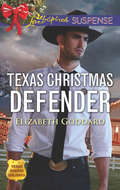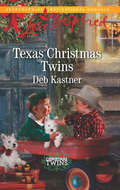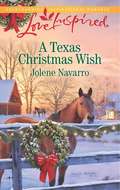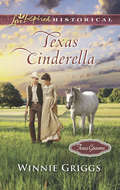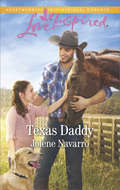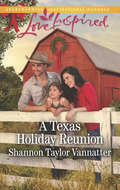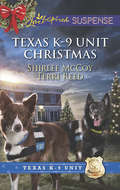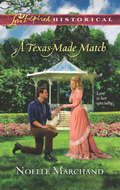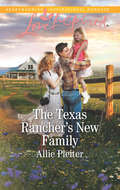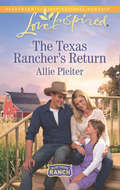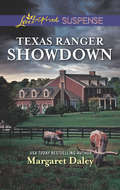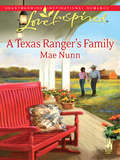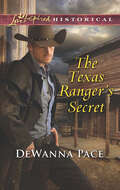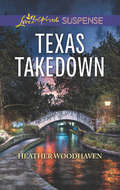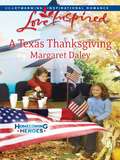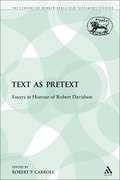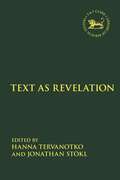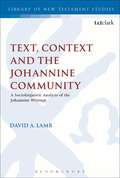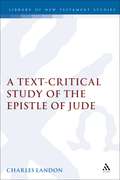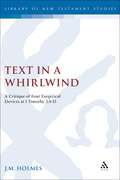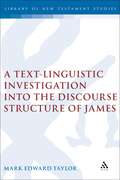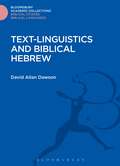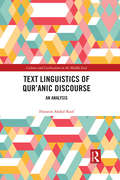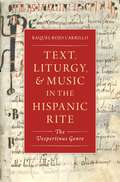- Table View
- List View
Texas Christmas Defender: Classified K-9 Unit Christmas Texas Christmas Defender Amish Christmas Abduction (Texas Ranger Holidays #3)
by Elizabeth GoddardTARGETED AT CHRISTMAS
Texas Christmas Twins: Texas Christmas Twins Amish Triplets For Christmas The Christmas Baby (Christmas Twins #3)
by Deb KastnerChristmas on the Ranch
A Texas Christmas Wish: A Reunion For The Rancher A Husband For Christmas A Texas Christmas Wish (Mills And Boon Love Inspired Ser. #1)
by Jolene NavarroKarly Kalakona's new nursing job is the perfect Christmas gift she and her son needed for their future. The single mom just never counted on dealing with not only a stubborn patient, but also with his prodigal son.
Texas Cinderella: A Rancher Of Convenience Texas Cinderella The Nanny's Little Matchmakers A Mother In The Making (Texas Grooms (Love Inspired Historical) #8)
by Winnie GriggsIn Search of a Groom
Texas Daddy: A Groom For Ruby, The Soldier's Secret Child, Texas Daddy (Lone Star Legacy (Love Inspired) #1)
by Jolene NavarroThe Cowboy’s Second Chance
A Texas Holiday Reunion: An Amish Proposal The Cowboy's Family Christmas A Texas Holiday Reunion (Texas Cowboys #3)
by Shannon Taylor VannatterHis Christmas Homecoming
Texas K-9 Unit Christmas: Holiday Hero Rescuing Christmas (Mills And Boon Love Inspired Suspense Ser. #7)
by Terri Reed Shirlee McCoyCHRISTMAS COMES WRAPPED IN DANGER…
A Texas-Made Match (Mills And Boon Love Inspired Historical Ser.)
by Noelle MarchandMATCHMAKER–MATCHED!
Texas Ranger Showdown: Texas Ranger Showdown Wilderness Pursuit Secret Past (Lone Star Justice #3)
by Margaret Daley"Stop me.” She was taunted by a killer.
A Texas Ranger's Family (Mills And Boon Love Inspired Ser.)
by Mae NunnPhotojournalist Erin Gray has seen the world through her camera. But she's never taken a snapshot of the husband and daughter she left behind years ago.
The Texas Ranger's Secret: Instant Frontier Family The Bounty Hunter's Redemption The Texas Ranger's Secret The Baby Barter (Mills And Boon Love Inspired Historical Ser.)
by DeWanna PaceRanger for hire
Texas Takedown: Amish Refuge Texas Takedown Shattered Secrets (Mills And Boon Love Inspired Suspense Ser.)
by Heather WoodhavenLETHAL SABOTAGE
A Texas Thanksgiving (Homecoming Heroes #5)
by Margaret DaleyA frozen turkey dinner is just fine for former soldier and widower Evan Paterson. But his five-year-old daughter deserves better. So when she invites her best friend and her single mother to the Double P ranch for the holiday meal, Evan agrees. But not to a fix-up.
Text as Pretext: Essays in Honour of Robert Davidson (The Library of Hebrew Bible/Old Testament Studies)
by Robert P. CarrollThis collection of essays in honour of Professor Robert Davidson celebrates a number of notable achievements of this outstanding Scottish churchman and scholar. It is published for the occasion of his sixty-fifth birthday, but it also marks his retirement from full-time university teaching and nods in the direction of his having been the Moderator of the General Assembly of the Church of Scotland (1990-91). The guiding principle governing this collection of essays is the notion of the Bible as the generator of other texts and cultural productions. The contributors are drawn from Davidson's wide range of colleagues and former students and focus on many different aspects of this generative force within the Bible itself and in materials related to it. Contributors include A.G. Auld, J.M.G. Barclay, E. Best, J.C.L. Gibson, W. Johnstone, H.A. McKay, J.K. Riches, and the editor, among others.
Text as Revelation (The Library of Hebrew Bible/Old Testament Studies)
Text as Revelation analyses the shift of revelatory experiences from oral to written that is described in ancient Jewish literature, including rabbinic texts. The individual essays seek to understand how, why, and for whom texts became the locus of revelation.While the majority of the contributors analyze ancient Jewish literature for depictions of oral and written revelation, such as the Hebrew Bible and the literature of the Second Temple era, a number of articles also investigate textualization of revelation in cognate cultures, analyzing Egyptian, Mesopotamian and Greek sources. With subjects ranging from Ancient Egyptian and Sibylline oracles to Hellenistic writings and the books of Isaiah, Deuteronomy and Jeremiah, the studies in this volume bring together established and new voices reflecting on the issues raised by the interplay between writing and (divinatory) revelation.
Text, Context and the Johannine Community: A Sociolinguistic Analysis of the Johannine Writings (The Library of New Testament Studies #477)
by David A. LambText, Context and the Johannine Community adopts a new approach to the social context of the Johannine writings by drawing on modern sociolinguistic theory. Sociolinguistics emphasizes language as a social phenomenon, which can be analysed with reference not only to its broad context of culture, but also, through the use of register analysis, to its narrower context of situation. The Johannine writings have increasingly been seen as the product of a distinct Johannine Community, depicted by some scholars as a sectarian group, opposed both to wider Jewish society and to other Christian groups. This model has largely been constructed on historical-critical grounds, yet given our lack of reliable external information about the origin of the Johannine writings, a more fruitful approach may be to examine their lexico-grammatical and discourse features to determine what these imply about interpersonal relationships. This study compares selected 'narrative asides' from the Gospel of John with a passage section from 1 John and with the two shorter Johannine Epistles. It concludes that register analysis of these texts does not support the idea of a close-knit sectarian group.
A Text-Critical Study of the Epistle of Jude (The Library of New Testament Studies #135)
by Charles LandonThe author writes in the tradition of C.H. Turner, G.D. Kilpatrick and J.K. Elliott, and attempts a reconstruction of the Greek text of Jude according to the rationale of thoroughgoing eclecticism. The aims of his study are to apply an eclectic approach to the resolution of textual problems in Jude, and to determine the extent to which the text of Jude published in the United Bible Societies' Greek New Testament (GNT4) is a product of the eclectic ideal. In this work, eclecticism is defined in detail, distinctions being made between eclectic generalism, rational criticism, and thoroughgoing eclecticism. Each of 95 variation units is analysed individually and the apparatus provided for each unit shows as much variation as possible in a compact form.
Text in a Whirlwind: A Critique of Four Exegetical Devices at 1 Timothy 2.9-15 (The Library of New Testament Studies #196)
by J. M. HolmesHolmes examines four exegetical devices employed by all sides in the debate on 1 Tim. 2.9-15, proposing that together they create a 'whirlwind' effect which obscures the text's meaning. She concludes that (1) the immediate context is general, not ecclesial; (2) background often reconstructed from passages elsewhere in the Pastorals is misleading; (3) comparison with 1 Cor. 14.34-35 can similarly mislead; and (4) the conjunction gar ('for') has been allowed unduly to dominate interpretation. The writer of the letter, it is argued, has been misunderstood since very early in the Christian era, his intention having been simply to moderate women's everyday behaviour in ways that parallel the behaviour he requires of men.
A Text-Linguistic Investigation into the Discourse Structure of James (The Library of New Testament Studies #311)
by Mark E. TaylorThis study uncovers significant structuring techniques in James that prove to be beneficial in a number of ways. First, there exists a coherent, discernible strategy in the letter as a whole. Second, significant uses of inclusio, along with other transition techniques, draw attention to important recurring themes. Third, the quotation of Lev. 19:18 and echoes of the Shema (Deut. 6) occur in significant structural locations suggesting that the double-love command in the Jesus tradition (cf. Mt. 22:34-40) is a hermeneutical key to the interpretation of the letter. The study begins with an introduction to the research problem and its significance for interpretation. Chapter one summarizes and critiques past proposals of the structure of James. Chapter two explains the text-linguistic methodology employed in the study that is then applied in chapters three, four, and five. Chapter six offers a proposed structure for the letter that consists of a double introduction (1:2-11 1:13-27) joined by an overlapping transition (1:12), a carefully crafted letter body (2:1-5:6) that is bracketed by a major inclusio (2:12-13 & 4:11-12), and a conclusion (5:7-20). LNTS
Text-Linguistics and Biblical Hebrew (The Library of Hebrew Bible/Old Testament Studies)
by David Allan DawsonModern linguistics is a relative newcomer in the scientific world, and text-linguistics, or discourse analysis, is one of its youngest disciplines. This fact has inclined many toward scepticism of its value for the Hebraist, yet much benefit is thereby overlooked. In this work, the author examines recent contributions to Hebrew text-linguistics by Niccacci, Andersen, Eskhult, Khan, and Longacre, evaluating them against a twofold standard of theoretical and methodological integrity, and clarity of communication. An extensive introduction to one particularly promising model of text analysis (from Longacre's tagmemic school) is given, and a step-by-step methodology is presented. Analyses according to this model and methodology are given of seven extended text samples, each building on the findings of the previous analyses: Judg. 2; Lev. 14.1-32; Lev. 6.1-7.37; parallel instructions and historical reports about the building of the Tabernacle, from Exodus 25-40; Judg. 10.6-12.7; and the book of Ruth in its entirety. Considerable attention is given to the question of text-linguistics and reported speech.
Text Linguistics of Qur'anic Discourse: An Analysis (Culture and Civilization in the Middle East)
by Hussein Abdul-RaofText Linguistics of Qur'anic Discourse is an in-depth investigation of the fabric of Qur'anic Discourse. It unravels the texture of the macro Qur'anic text; its cohesion and coherence systems; the notions of intertextuality, semantic relatedness, and thematic sequentiality; the macro textual features of ellipsis, repetition, and argumentation structure; and the contextual, co-textual, grammatical, and semantic factors involved in the macro Qur'anic text. This book is a valuable and methodologically consistent learning and teaching academic resource for universities worldwide in this intriguing new discipline. Through its methodologically coherent discussion and in-depth analysis that is hinged upon modern European text linguistics, Text Linguistics of Qur'anic Discourse provides an insight into the newly established discipline of text linguistics, and explores the different layers of the macro Qur'anic text as an academic requirement.
Text Linguistics of Qur'anic Discourse: An Analysis (Culture and Civilization in the Middle East)
by Hussein Abdul-RaofText Linguistics of Qur'anic Discourse is an in-depth investigation of the fabric of Qur'anic Discourse. It unravels the texture of the macro Qur'anic text; its cohesion and coherence systems; the notions of intertextuality, semantic relatedness, and thematic sequentiality; the macro textual features of ellipsis, repetition, and argumentation structure; and the contextual, co-textual, grammatical, and semantic factors involved in the macro Qur'anic text. This book is a valuable and methodologically consistent learning and teaching academic resource for universities worldwide in this intriguing new discipline. Through its methodologically coherent discussion and in-depth analysis that is hinged upon modern European text linguistics, Text Linguistics of Qur'anic Discourse provides an insight into the newly established discipline of text linguistics, and explores the different layers of the macro Qur'anic text as an academic requirement.
Text, Liturgy, and Music in the Hispanic Rite: The Vespertinus Genre (Currents in Latin American and Iberian Music)
by Raquel Rojo CarrilloThe Hispanic rite, a medieval non-Roman Western liturgy, was practiced across the Iberian Peninsula for over half a millennium and functioned as the most distinct marker of Christian identity in this region. As Christians typically began every liturgical day throughout the year by singing a vespertinus, this chant genre in particular provides a unique window into the cultural and religious life of medieval Iberia. The Hispanic rite has the largest corpus of extant manuscripts of all non-Roman liturgies in the West, which testifies to the importance placed on their transmission through political and cultural upheavals. Its chants, however, use a notational system that lacks clear specification of pitch and has kept them barred from in-depth study. Text, Liturgy and Music in the Hispanic Rite is the first detailed analysis of the interactions between textual, liturgical, and musical variables across the entire extant repertoire of a chant genre central to the Hispanic rite, the vespertinus. By approaching the vespertini through a holistic methodology that integrates liturgy, melody, and text, author Raquel Rojo Carrillo identifies the genre's norms and traces the different shapes it adopts across the liturgical year and on different occasions. In this way, the book offers an unprecedented insight into the liturgical edifice of the Hispanic rite and the daily experience of Christians in medieval Iberia.
